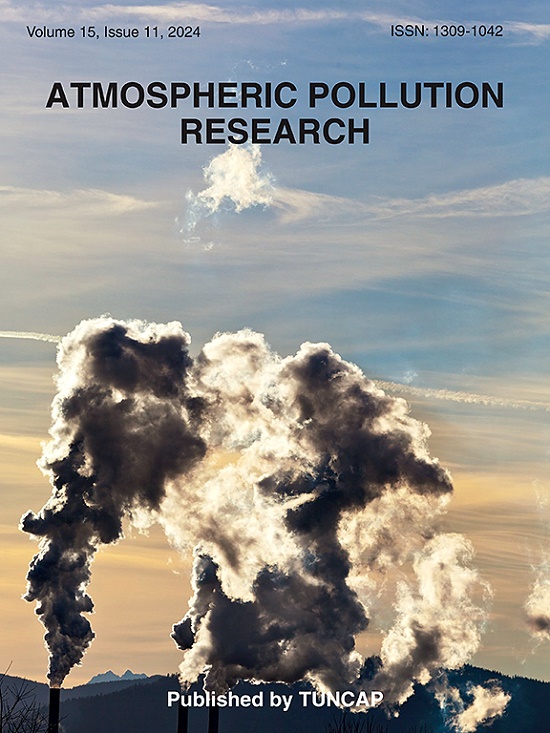使用长期AERONET数据的安哥拉三个城市的气溶胶光学特性
IF 3.9
3区 环境科学与生态学
Q2 ENVIRONMENTAL SCIENCES
引用次数: 0
摘要
气溶胶可以通过散射或吸收太阳辐射来影响气候。气溶胶的存在也可能影响人类健康,因为接触它们与肺部和心血管疾病有关。利用气溶胶机器人网络(AERONET)数据,研究了2016 - 2021年安哥拉万博、卢班戈和纳米贝三个地点气溶胶光学特性、主要气溶胶类型、气溶胶可能来源和气溶胶辐射强迫的时空变化趋势。结果表明:3个站点的气溶胶光学深度(AOD)在以降雨为特征的暖月有所减少,AOD的最小负荷在0.073 ~ 0.132之间变化;万博的生物质燃烧气溶胶比例最高(79%),其次是卢班戈(56%)和纳米贝(21%)。Lubango的Ångström指数(AE)在1.48 ~ 1.52之间,表明存在细模气溶胶粒子。体积大小分布(VSD)的年平均值表明,万博的细态气溶胶粒子浓度最高(0.053 μm3/μm2),高于纳米贝(0.034 μm3/μm2)和卢班戈(0.030 μm3/μm2)。细颗粒的平均峰半径约为0.15 μm,而粗颗粒在Huambo和Lubango的平均峰半径(5.06 μm)均大于纳米be的平均峰半径(3.86 μm)。在所有站点中,纳米贝的粗态气溶胶粒子年平均VSD最高。此外,调查结果显示,3个站点大气底部(BOA)的年平均气溶胶辐射强迫(ARF)在万博最高(- 53.63 Wm-2),而大气顶部(TOA)的ARF在- 13.91 ~ -9.59 Wm-2之间变化。年平均ARF效率(ARFE)在Lubango的BOA值较高(- 214.57 Wm-2 / AOD),而在Huambo的TOA值为- 60.27 Wm-2 / AOD)。从目前的研究中获得的发现总结了安哥拉三个地点的气溶胶光学特性,这可以丰富气溶胶直接辐射对该国部分地区影响的知识,从而增强该地区未来的气候模式。本文章由计算机程序翻译,如有差异,请以英文原文为准。
Aerosol optical properties over three cities of Angola using long term AERONET data
Aerosols can influence the climate, by scattering or absorbing solar radiation. The presence of aerosols may also affect human health as their exposure has been linked to pulmonary and cardiovascular diseases. This paper aims to investigate the spatiotemporal trends of aerosol optical properties, the major types of aerosols, the possible sources of the aerosols, and the aerosol radiative forcing at three locations in Angola, namely, Huambo, Lubango, and Namibe, using the Aerosol Robotic Network (AERONET) dataset from 2016 to 2021. The results revealed that at the three sites, there was a decrease in the aerosol optical depth (AOD) during the warm months, a period characterized by rainfall, and the minimum loadings of AOD varied between 0.073 and 0.132. Huambo registered the highest percentages of biomass-burning aerosols (79 %), followed by Lubango (56 %) and Namibe (21 %). The Ångström exponent (AE) at Lubango ranged from 1.48 to 1.52, denoting the existence of fine-mode aerosol particles. The annual mean of the volume size distribution (VSD) showed that among the three sites, Huambo registered the highest concentration of fine-mode aerosols particles (0.053 μm3/μm2) when compared with Namibe (0.034 μm3/μm2) and Lubango (0.030 μm3/μm2). The mean peak radius of the fine particle over the three sites was about 0.15 μm, while the mean peak radius of the coarse particle registered at both Huambo and Lubango (5.06 μm) was greater than the one at Namibe (3.86 μm). Namibe had the highest annual mean of VSD for coarse-mode aerosol particles among all sites. Further, an investigation revealed that the annual mean aerosol radiative forcing (ARF) at the bottom of the atmosphere (BOA) was the highest at Huambo (−53.63 Wm-2), while the ARFs at the top of the atmosphere (TOA) varied between −13.91 Wm-2 and -9.59 Wm-2, among the three sites. The annual mean ARF efficiencies (ARFE) showed a higher value at BOA at Lubango (−214.57 Wm-2 per AOD), whilst at TOA, it was recorded at Huambo (−60.27 Wm-2 per AOD). The findings obtained from the current study provide a summary of the aerosol optical properties at three sites in Angola, which could enrich the knowledge of the influence of aerosol direct radiative impact over parts of the country and so enhance future climate models of this region.
求助全文
通过发布文献求助,成功后即可免费获取论文全文。
去求助
来源期刊

Atmospheric Pollution Research
ENVIRONMENTAL SCIENCES-
CiteScore
8.30
自引率
6.70%
发文量
256
审稿时长
36 days
期刊介绍:
Atmospheric Pollution Research (APR) is an international journal designed for the publication of articles on air pollution. Papers should present novel experimental results, theory and modeling of air pollution on local, regional, or global scales. Areas covered are research on inorganic, organic, and persistent organic air pollutants, air quality monitoring, air quality management, atmospheric dispersion and transport, air-surface (soil, water, and vegetation) exchange of pollutants, dry and wet deposition, indoor air quality, exposure assessment, health effects, satellite measurements, natural emissions, atmospheric chemistry, greenhouse gases, and effects on climate change.
 求助内容:
求助内容: 应助结果提醒方式:
应助结果提醒方式:


